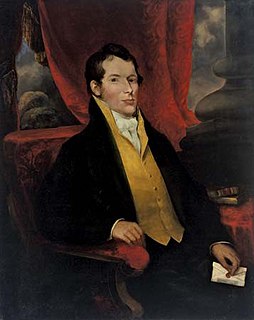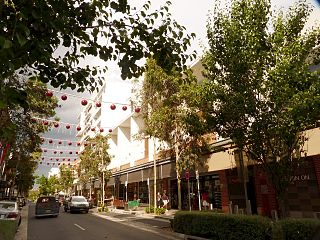Richard Rouse | |
|---|---|
| Born | 26 February 1774 |
| Died | 10 May 1852 (aged 78) |
| Nationality | Anglo-Australian |
| Occupation | Public servant; Colonial superintendent of works |
Notable work |
|
| Spouse(s) | Elizabeth Adams |
Richard Rouse (26 February 1774 –10 May 1852) was an Anglo-Australian public servant who was active during the Colonial development of New South Wales as the Superintendent of Public Works and Convicts at Parramatta under the direction of NSW Governors William Bligh and Lachlan Macquarie. He is attributed as the designer of Rouse Hill House in Rouse Hill, that was his family home from 1819 until his death in 1852. [1]
Rouse was born in Oxfordshire, England in 1774. He arrived in Sydney in December 1801 as a free settler with his wife, Elizabeth Adams, and their two young children. In March 1802 Governor Philip Gidley King granted Rouse 40 hectares (100 acres) and he established on a farm at North Richmond on the Hawkesbury River. In July 1805 he was appointed superintendent of lumberyard at Parramatta. [2]
In 1806 Rouse welcomed Governor Bligh against the despotism of the New South Wales Corps and was one of the governor's staunchest supporters. After sympathizing with Bligh, he was named by Bligh as one of the witnesses he wished to take to England. However, the trip did not eventuate as Bligh changed his mind. Rouse his position as a public servant. On 14 January 1810 he was appointed superintendent of carpenters by Governor Macquarie and in October 1814 was appointed auctioneer at Parramatta. He superintended the construction of many buildings, tollhouses and turnpikes in the vicinity of Parramatta, Windsor and Liverpool, including the renovation of Old Government House, Parramatta, in 1815 and the erection of the Parramatta Hospital in 1818. [2]
On 8 October 1816 Rouse was granted 180 hectares (450 acres) near the site of the Castle Hill convict rebellion; at the suggestion of Macquarie the grant was named Rouse Hill. The actual possession of the land had taken place a few years previously, as the Sydney Gazette had first mentioned Rouse Hill on 27 November 1813, and the homestead was begun soon afterwards. It took a few years to build and was a two-storey, twenty-two room house, which has been occupied by members of the Rouse family ever since. [1] [3] [4] [5]
In 1822 Rouse sent his sons in search of good pasturage in the area north-west of the Blue Mountains; and in 1825 they took up land for him 140 kilometres (90 mi) north of Bathurst on the Cudgegong River near Gulgong. This grant of 1,600 hectares (4,000 acres) was gradually increased, and became two stations, Guntawang and Biraganbil, which were inherited by his sons Edwin and George. Both properties prospered and the Rouses were connected with progressive movements in the towns of Mudgee and Gulgong for many years. Rouse also acquired Ewenmar on the Castlereagh River, Gillendoon near Warren, Cobborah near Wellington and other land at Bathurst as well as the properties at Penrith and Richmond. By 1828 he possessed about 4,000 hectares (10,000 acres), but by then he had retired to Rouse Hill. There he devoted his time to the raising of sheep and cattle, the breeding of thoroughbred horses and the management of his various properties. He became well known for the quality of his stock, which he improved from time to time with imported sires. [2]
Rouse was a devoted family man, a loyal member of the Church of England, a hard-working and honest public servant and a very efficient grazier. His many properties ensured the future of his three sons and four daughters who survived childhood, including Mary, the eldest, who married Jonathan, son of the missionary Rowland Hassall; Jane who married Alfred Kennerley, premier of Tasmania in 1873-76; Eleanor who married first John Terry of Box Hill, son of Samuel Terry and after his death, Major Thomas Wingate; George, one of the first boys enrolled at The King's School, Parramatta, when it opened in 1832; and Elizabeth Henrietta who married Robert, son of Richard Fitzgerald of Windsor. [2]
Elizabeth Rouse died in December 1849 and Richard Rouse died on 10 May 1852. He was buried in a vault at St Peter's Church, Richmond. [2]
One of his grandsons was Richard Rouse who served as the Member for Mudgee between 1876 and 1877; and in 1879. [6] [7]

Camperdown is an inner western suburb of Sydney, in the state of New South Wales, Australia. Camperdown is located 4 kilometres south-west of the Sydney central business district and is part of the Inner West region. Camperdown lies across the local government areas of the City of Sydney and Inner West Council.

Francis Howard Greenway was an English-born architect who was transported to Australia as a convict for the crime of forgery. In New South Wales he worked for the Governor, Lachlan Macquarie, as Australia's first government architect. He became widely known and admired for his work displayed in buildings such as St Matthew's Church in Windsor, New South Wales, St James' Church, Sydney and Hyde Park Barracks, Sydney.

Gulgong is a 19th-century gold rush town in the Central Tablelands and the wider Central West regions of the Australian state of New South Wales. The town is situated within the Mid-Western Regional Council local government area. It is located about 300 km (190 mi) north west of Sydney, and about 30 km north of Mudgee along the Castlereagh Highway. At the 2016 Census, Gulgong had a population of 2,521.
D'Arcy Wentworth was an Irish surgeon, the first paying passenger to arrive in the new colony of New South Wales. He served under the first seven governors of the colony. From 1810 to 1821, he was great assistant to Governor Lachlan Macquarie.

John Macarthur was a British army officer, entrepreneur, politician, architect and pioneer of settlement in Australia. Macarthur is recognised as the pioneer of the wool industry that was to boom in Australia in the early 19th century and become a trademark of the nation. He is noted as the architect Farm House, his own residence in Parramatta, and as the man who commissioned architect John Verge to design Camden Park Estate in Camden, in New South Wales. He was instrumental in agitating for, and organising, a rebellion against the colonial government in what is often described as the Rum Rebellion.

Rouse Hill is a suburb of Sydney, in the state of New South Wales, Australia. Rouse Hill is located in the Greater Western Sydney Region, 43 kilometres north-west of the Sydney central business district and 19 kilometres north-west of the Parramatta central business district. It is in the local government areas of The Hills Shire and City of Blacktown. Rouse Hill Town Centre is at the heart of the suburb, which contains a busy Town Square.

The Parramatta Female Precinct, in the former penal colony of New South Wales, is located in the grounds of Cumberland Hospital, North Parramatta, New South Wales, Australia. It was one of 13 female factories in the colonies of New South Wales and Van Diemen's Land. In New South Wales, female factories were also established in Bathurst, Newcastle, Port Macquarie and Moreton Bay. The factory idea was a combination of the functions of the British bridewells, prisons and workhouses.

The Old Government House is a heritage-listed former "country" residence used by ten early governors of New South Wales between 1800 and 1847, located in Parramatta Park in Parramatta, New South Wales, in the greater metropolitan area of Western Sydney, New South Wales, Australia. It is considered a property of national and international significance as an archaeological resource. It also serves to demonstrate how the British Empire expanded and Australian society has evolved since 1788.

St John's Cathedral is a heritage-listed, Anglican cathedral in Parramatta, City of Parramatta, Sydney, New South Wales, Australia. St John's was given the status of provisional cathedral of the Anglican Diocese of Sydney in 1969, and designated a Regional Cathedral in 2011 for the Western Region. It was added to the New South Wales State Heritage Register on 5 March 2010.
Richard Rouse was an Australian politician.

Rouse Hill House is a heritage-listed homestead and estate at Windsor Road, Rouse Hill, City of Blacktown, New South Wales, Australia. Rouse Hill House and farm was the family home of Richard Rouse, the Colonial Superintendent of Public Works and Convicts at Parramatta.

The Veteran Hall Remains are the heritage-listed archaeological remains of the former Veteran Hall house at Great Western Highway, Prospect, City of Blacktown, New South Wales, Australia. Veteran Hall was built in 1821 by William Lawson. The property is owned by Sydney Water. It was added to the New South Wales State Heritage Register on 18 November 1999.

The Hunting Lodge is a heritage-listed colonial era hunting lodge located at The Water Lane in Rouse Hill in The Hills Shire local government area of New South Wales, Australia. It was added to the New South Wales State Heritage Register on 2 April 1999.

Box Hill House is a heritage-listed former hunting grounds and farm estate and now residential support home at 10 Terry Road, Box Hill, The Hills Shire, New South Wales, Australia. It was built from 1819 to 1897 by Samuel Terry and George Terry. It is also known as McCall Garden Colony, Box Hill House in grounds of McCall gardens, McCall Gardens and Box Hill estate. The property is privately owned. It was added to the New South Wales State Heritage Register on 2 April 1999.

Macquarie Arms Hotel is a heritage-listed hotel at Thompson Square, Windsor, City of Hawkesbury, New South Wales, Australia. It is also known as the Royal Hotel. It was added to the New South Wales State Heritage Register on 2 April 1999.

Mountain View is a heritage-listed residence at 22 Inalls Lane, Richmond, City of Hawkesbury, New South Wales, Australia. It was built from 1804 to 1870 by Lewis Jones and James Vincent. It is also known as Dight's Farm. It was added to the New South Wales State Heritage Register on 2 April 1999.

Denham Court is a heritage-listed former residence and farm estate and now residence located at 238 Campbelltown Road, Denham Court in the City of Campbelltown local government area of New South Wales, Australia. It was designed by John Verge and built from 1820 to 1829. The property is privately owned. It was added to the New South Wales State Heritage Register on 2 April 1999.

Varroville is a heritage-listed former farm and now rural residence at 196 St Andrews Road, Varroville in the City of Campbelltown local government area of New South Wales, Australia. It was designed by Weaver and Kemp and built from 1810 to 1859. It is also known as Varro Ville and Varra Ville. The property is privately owned. It was added to the New South Wales State Heritage Register on 2 April 1999.